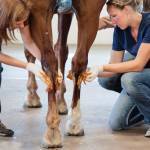Understanding Osteoarthritis in Horses: A Closer Look at Synovial Fluid

Early diagnosis of osteoarthritis is key to initiating therapies that may slow disease progression and preserve athleticism. Unfortunately, no tests are available to accurately diagnose osteoarthritis early in the course of the disease. Researchers are therefore focusing on creating a “synovial fluid metabolome” to identify biomarkers that may expedite the diagnostic process.
Synovial fluid is the thick, lubricating liquid found inside joints that bathes the layer of articular cartilage lining the ends of long bones during weight bearing. Veterinarians analyze synovial fluid to identify an infected joint by looking for bacteria, white blood cells, and total protein levels.
Analyzing synovial fluid to assess the health of a joint is therefore not a new procedure, but synovial fluid analysis can do a lot more than simply verify joint infection.
“Evaluating synovial fluid using ‘omics science’ can help achieve an early diagnosis of osteoarthritis, a common cause of lameness and loss of athletic function in horses. Recognizing osteoarthritis early in the course of disease using synovial fluid markers allows us to initiate therapy before extensive destruction of articular cartilage,” explained Kathleen Crandell, Ph.D., a nutritionist for Kentucky Equine Research. “Disease progression can be monitored and may provide more information about how the disease develops at a molecular level.”
The goals of omics science are to identify, describe, and quantify biomolecules and molecular processes that contribute to the form and function of cells and tissues. Examples include genomics (the study of DNA and RNA), proteomics (the study of proteins), and metabolomics (the study of metabolites). Metabolites are molecules produced by cells during normal cellular processes involved in the maintenance and growth of cells.
Italian researchers recently used synovial fluid metabolomics to explore the difference in metabolites in synovial fluid collected from healthy and arthritic horses.* Those samples were analyzed using a procedure called proton nuclear magnetic resonance (H-NMR), which can determine the structure of molecules in a sample.
In total, 55 different synovial fluid metabolites were identified and quantified, and 19 of those were significantly different between samples collected from healthy horses and those with osteoarthritis.
“Several amino acids were lower in the synovial fluid samples collected from horses with osteoarthritis, as well as creatine, creatinine, choline, and a variety of other molecules. In contrast, only a molecule called 1-3-dihydroxyacetone was higher in samples from arthritic joints,” Crandell said.
In this pilot study, no further evaluation of the role of these metabolites in synovial fluid or osteoarthritis was performed. The researchers concluded that “a variety of molecules undergo significant changes during joint disease,” which could be a result of reduced efficiency in balancing pro- and anti-inflammatory pathways in osteoarthritis joints.
According to Crandell, “Additional metabolomic studies are in progress, as this type of research may help identify biomarkers of osteoarthritis, allow us to better understand the disease, and one day find a way to prevent osteoarthritis.”
For now, Crandell says that preventive measures all horse owners can implement for protecting their horses’ joints from osteoarthritis include using preparations developed to counteract inflammation, reduce cartilage damage, and stimulate cartilage repair.
“Well-known joint support compounds include glucosamine, chondroitin, and sodium hyaluronate. The high molecular weight sodium hyaluronate in Synovate HA contributes significantly to cartilage health and elasticity, joint fluid viscoelasticity, and lubrication of the entire joint mechanism,” Crandell summarized.
Weight management is another effective strategy for improving joint comfort.
“Keeping horses at an optimum body weight may avoid some of the pitfalls of the increased stress on joint structures, eventually leading to unsoundness in some horses. Optimal body condition will minimize excessive weight bearing on the delicate joint tissues, which can be even more important if the tissues are already inflamed,” added Crandell.
*Laus, F., R. Gialletti, M. Bazzano, L. Laghi, F. Dini, and A. Marchegiani. 2023. Synovial fluid metabolome can differentiate between healthy joints and joints affected by osteoarthritis in horses. Metabolites 13(8):913.








